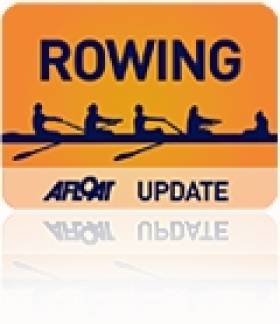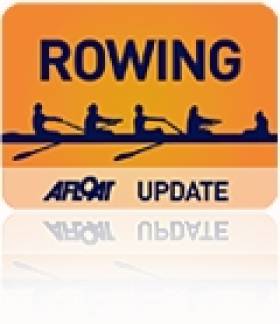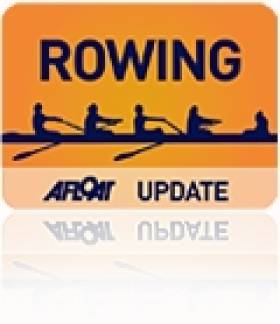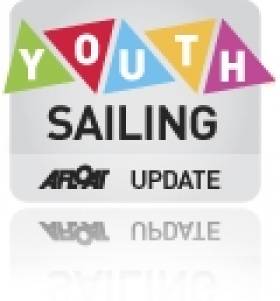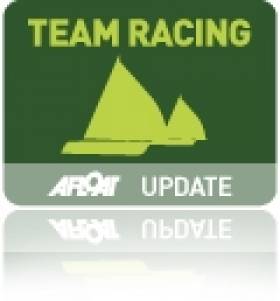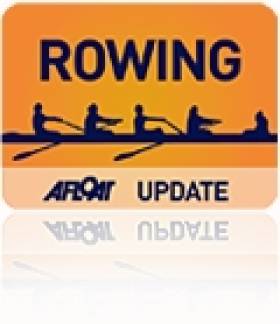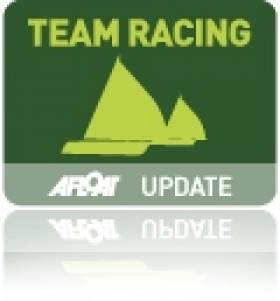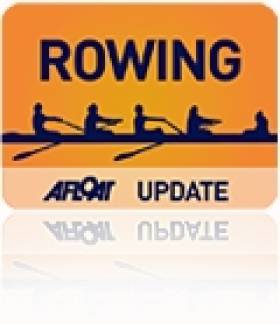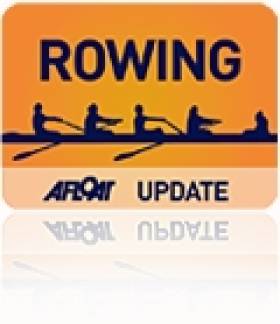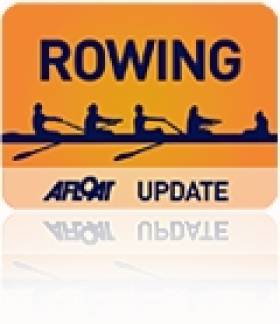Displaying items by tag: UCD
UCD/Old Collegians Fastest Quadruple at Cork Regatta
# Rowing: The composite quadruple from UCD and Old Collegians were impressive victors at Cork Regatta. Commercial, who beat them at Dublin Metropolitan, were left behind as the crew of Dave Neale, Albert Maher, Sean Jacob and new man Turlough Hughes won well. Skibbereen won the women’s Division One quadruple, while Commercial won the women’s Division Two eights in an exciting race. UCD’s intermediates were the top coxed four – beating Queen’s in a good race.
Cork Regatta, National Rowing Centre (Selected Results)
Saturday
Men
Four, coxed – Div One – A Final: 1 UCD (inter) 6:27.52, 2 Queen’s (inter) 6:28.52, 3 UCD B (inter) 6:29.16; 4 Skibbereen (sen) 6:38.0. B Final: St Michael’s (inter) 6:53.83; 2 St Michael’s (jun 18A) 6:39.19.
Sculling
Quadruple – Div One – A Final: 1 Old Collegians/UCD (sen) 5:58.95, 2 Commercial (sen) 6:06.11, 3 Castleconnell (jun 18A) 6:15.80. B Final: Cork B (jun 18A) 6:24.97.
Double – Div Two – A Final: 1 Cork C (jun 16) 7:07.81, 2 Lee (jun 16) 7:14.63, 3 Shandon A (club two) 7:20.63; 6 Carlow (jun 18B) 7:27.78. B Final: Waterford A (jun 16) 7:26.43. C Final: Shannon B (jun 18B) 7:22.38.
Women
Eight – Div Two – A Final: 1 Commercial (Club Two) 6:47.24, 2 Queen’s (Club Two) 6:51.15, 3 Col Iognaid (Jun 16) 7:06.11.
Four – Div One, coxed – A Final: 1 NUIG (inter) 7:15.85, 2 Shannon (sen) 7:20.47, 3 Commercial (inter) 7:21.80. B Final: Garda (Club One) 7:48.47.
Sculling
Quadruple – Div One – A Final: 1 Skibbereen (jun 18A) 6:51.67, 2 Lee (Jun 18A) 7:00.6, 3 Galway (jun 18A) 7:27.46.
Double – Div Two – A Final: 1 Workmen’s (jun 16) 7:43.13, 2 Cork (Club Two), Cork (jun 16) 7:48.08, 4 Shandon (jun 18B) 7:48.74. B Final: Lee (jun 18B) 8:05.00. C Final: Workmen’s (jun 18B) 8:41.15.
#ROWING: Commercial won the battle of the men’s quadruples at Dublin Metropolitan Regatta. The established unit were tested by Skibbereen down the Blessington course, but won well. The experienced oarsman in the Old Collegians boat, with Albert Maher joining Sean Jacob, Dave Neale and Eimantas Grigalius, finished third. The NUIG/Grainne Mhaol men’s senior eight set a good time while winning the Division One final, despite being clearly superior to their intermediate opposition. UCD provided the top women’s pair and four. The women’s single had a strange set of finals. Elise Maurin won her heat but the progression by fastest time (of which she was unaware) consigned her to the B Final – which she won in a much faster time than set by junior competitor Erin Barry in winning the A Final.
The new timing system for heats worked well and the regatta ran exactly to schedule in excellent conditions.
Dublin Metropolitan Regatta, Blessington, Saturday
Men
Eight – Division One – A Final: NUIG/Grainne Mhaol (sen) 6:11.863, 2 Rudergesellschaft Wiking Berlin (inter) 6:21.173, 3 UCD (inter) 6:22.163; 4 St Michael’s (jun 18A) 6:41.850.
Div Two – A Final: 1 Cork BC (Club Two) 6:15.297, 2 NUIG (Club Two) 6:15.873, 3 Commercial (Club Two) 6:22.777; 4 UCD (Nov) 6:21.543; 5 Col Iognaid (jun 16) 6:40.310.
Four – Division One – A Final: 1 NUIG/Grainne Mhaol (sen) 6:21.603, 2 Commercial (sen) 6:28.590, 3 Carlow (sen) 6:39.810.
Four, coxed – Div One – A Final: 1 Rudergesellschaft Wiking Berlin (inter) 6:48.173, 2 Skibbereen (inter) 6:51.123, 3 UCD A (inter) 6:52.57; 5 UCD A (Club One) 7:09.843, 6 Athlunkard (jun 18A) 7:12.387. B Final: CAI (jun 18A) 8:37.280. Div Two – A Final: 1 Skibbereen (Club Two) 7:06.850, 2 NUIG A (Club Two) 7:18.223, 3 Col Iognaid A (jun 16) 7:27.490. B Final: 1 UCD (Club Two) 7:22.253; 3 Lee (jun 18B) 7:46.653.
Pair – Division One – A Final: 1 Carlow (sen) 7:00.373, 2 St Michael’s (sen) 7:01.760, 3 Carlow (inter) 7:09.357; 4 St Michael’s A (jun 18A) 7:12.590. B Final: 1 UCD A (inter) 7:14.300, 2 St Michael’s (Club One) 7:17.827.
Sculling,
Quadruple – Div One – A Final: 1 Commercial (sen) 6:31.557, 2 Skibbereen (sen) 6:34.490, 3 Old Collegians (sen) 6:36.673; 5 Cork BC (jun 18A) 6:49.217. Div Two – A Final: 1 Cork BC 6:59.537, 2 Lee (jun 16) 7:04.77, 3 Cork BC (jun 18B) 7:06.493. B Final: Graiguenamanagh (jun 18B) 7:39.147; 2 Commercial (club two) 7:46.617. C Final: Neptune (nov) 8:33.443.
Double – Div One – A Final: 1 Old Collegians (sen) 7:07.373, 2 UCD/Portadown (sen) 7:11.603, 3 St Michael’s (inter) 7:13.740; 4 Garda (Club One) 7:15.670. B Final: Lee (jun 18A) 7:59.930. Div Two – A Final: 1 Shandon B (Club Two) 7:30.470, 2 Waterford (Club Two) 7:46.707, 3 Three Castles (jun 16) 7:47.227; 5 St Michael’s (jun 18B) 7:57.393. B Final: Skibbereen (jun 18B) 8:08.357.
Single – Div One – A Final: 1 Skibbereen (E Rowan, sen) 7:23.600, 2 Portadown (S McKeown, sen) 7:23.817, 3 Garda (D Kelly, inter) 7:33.333. B Final: 1 Shandon (S O’Sullivan; jun 18A) 7:40.700; 5 Garda (R Allen; Club One) 7:47.357. C Final: 1 UCD (R O’Sullivan; Club One) 7:46.767. Div Two – A Final: 1 Skibbereen (K Mannix, jun 18B) 7:48.270, 2 Commercial (E Meehan, jun 16) 7:54.950, 3 Graiguenamanagh (A Lennon, jun 18B) 7:57.740; 5 Shandon (D Smith, Club Two) 8:00.627. B Final: Castleconnell (A Mozdzer, Club Two) 8:04.933. C Final: Graiguenamanagh (K Scully, jun 18B) 8:05.560.
Women
Eight – Division One – A Final: 1 Skibbereen (jun 18A) 7 mins 6.773 secs, 2 Trinity (sen) 7:13.667, 3 St Michael’s (jun 18A) 7:15.690; 4 Trinity B (Club One) 7:55.210. Division Two – A Final: 1 Commercial (Club Two) 7:32.520, 2 Shandon (jun 16) 7:43.393, 3 NUIG (Club Two) 7:44.207; 4 Galway (Jun 18B) 7:46.857. B Final: 1 Commercial (jun 16) 7:59.867; 2 Trinity (nov) 8:10.273.
Four – Div One – A Final: 1 UCD (sen) 8:25.937, 2 Skibbereen (jun 18A) 8:26.170, 3 NUIG (sen) 8:33.670.
Four, coxed – Div One – A Final: 1 UCD B (inter) 7:20.803, 2 UCD A (inter) 7:24.170, 3 NUIG (inter) 7:28.417. Div Two – A Final: 1 NUIG (Club Two) 8:01.323, 2 Commercial (Club Two) 8:16.833, 3 Athlunkard (Club Two) 8:28.237.
Pair –Div One – A Final: 1 UCD (sen) 8:31.340, 2 Commercial B (inter) 8:34.460, 3 Bann (jun 18A) 8:39.267. B Final: 1 St Michael’s (jun 18A) 9:05.617; 2 Athlunkard (Club One) 9:31.823.
Sculling
Quadruple – Div One – A Final: Lee (jun 18A) 7:10.203, 2 Skibbereen (jun 18A) 7:14.900, 3 Bann (jun 18A) 7:15.943; 4 Carlow (Club One) 7:32.560. Div Two – A Final: 1 Commercial (jun 16) 7:38.500, 2 Shandon A (jun 16) 7:46.817, 3 Garda (Club Two) 7:50.140; 5 Cork BC (jun 18B) 7:54.523. B Final: Commercial A (nov) 7:57.957.
Double – Div One – A Final: 1 Skibbereen (jun 18A) 7:35.167, 2 Bann (jun 18A) 7:42.297, Skibbereen (sen) 8:12.747; 4 Castleconnell (Club One) 8:14.730. Div Two – A Final: 1 Bann (jun 18B) 8:00.347, 2 Garda (Club Two) 8:12.923, 3 Carlow (jun 18B) 8:48.290; 5 Castleconnell (jun 16) 9:10.130. B Final: Castleconnell (jun 18B) 9:00.677.
Single – Division One – A Final: 1 Bann (E Barry; jun 18A) 9:06.307, 2 Lee (C Synnott; jun 18A) 9:09.533, 3 Bann (B Mullin; jun 18A) 9:20.487. B Final: 1 New Ross (E Maurin; sen) 9:00.437; 2 St Michael’s (A O’Sullivan; inter) 9:01.187, 3 Fermoy (S Bouanane; Club One) 9:19.283. C Final: Skibbereen (B Walsh; sen) 9:41.843.
Div Two – A Final: 1 Bann (H Scott; jun 16) 9:02.560, 2 Bann (F Chestnutt, jun 18B) 9:12.593, 3 Garda (S Kenny, Club Two) 9:20.207. B Final: Castleconnell (R Kilkenny; Club Two) 11:35.533. C Final: Fermoy (A Collins; Club Two) 9:39.823.
UCD Intermediate Eight Win at Trinity Regatta
#Rowing: UCD took some late and notable wins at Trinity Regatta in Islandbridge today. They won the intermediate men’s eight final with a convincing win over the hosts, and also took the club eights with a win over Queen’s. Trinity’s A crew had just one and a quarter lengths to spare over their B crew in the men’s senior eights final – suggesting that had UCD put out a senior eight there could have been a good race. Commercial’s Neil Gahan and Colm Dowling won the senior pair and were part of Commercial’s winning four, while Damien Kelly won the senior single sculls, beating Fionnán Groome, and the intermediate single, where he was given a serious test by clubmate Ronan Allen. Bann won the junior 18 women’s eight and coxed four.
Trinity Regatta, Islandbridge, Saturday (Finals, Selected Results):
Men
Eight – Senior: Trinity A bt Trinity B 1¼ l. Intermediate: UCD bt Trinity 3¾ l. Club: UCD A bt Queen’s ¼ l. Novice: Queen’s bt Trinity A 3ft. Jun 16: Commercial bt Methodist canvas. Junior 15: Reading A bt Commercial ½l. Masters: Neptune bt Old Collegians ¼l.
Four – Senior, coxed: Commercial A bt Trinity B 4l. Intermediate, coxed: UCD bt Cork 1¾ l. Club, coxed: UCD B bt UCD A 2½ l. Masters, coxed: Neptune bt Commercial ¼l.
Pair – Senior: Commercial B bt Lady Elizabeth/Old Collegians easily.
Sculling
Quadruple – Novice, coxed: Reading bt Trinity easily. Jun 18B, coxed: Athlone bt Graiguenamanagh 1½ l. Junior 16, coxed: Methody bt Three Castles 1l. Jun 15, coxed: Graiguenamanagh bt Commercial A easily.
Double – Senior: Trinity bt Belfast 4½ l. Jun 15: Neptune bt Reading easily.
Single – Senior: Garda (D Kelly) bt Commercial (F Groome) 1¼ l Club: Garda (R Allen) bt Trinity (Browne) easily. Intermediate: Garda (D Kelly) bt Garda (R Allen) 1l. Jun 18: Athlone (Munnelly) bt Graiguenamanagh (Lennon) easily. Jun 16: Athlone (Byrne) bt Three Castles (Irwin) 1l. Jun 15: Commercial bt Neptune 3l. Masters: Commercial (O’Toole) bt Belfast BC (Curran) 1½ l
Women
Eight –Intermediate: Trinity bt Queen’s easily. Club: Commercial bt Queen’s 2¾ l. Novice: Queen’s bt Methodist College, Belfast easily. Jun 18: Bann bt Neptune easily. Jun 16: Commercial bt Bann 2¾ l.
Four – Club, coxed: Garda bt UCD ¼ l. Jun 18, four: Bann bt Methody easily.
Sculling
Quadruple – Novice, coxed: Carlow bt UCD easily. Jun 18B, coxed: Bann bt Carlow 1¼ l. Jun 16, coxed: Carlow bt Commercial canvas. Junior 15, coxed: Commercial bt Carlow 2l.
Double – Jun 15: Athlone bt Commercial 4l.
Single – Club One: Methody (Deyermond) bt Garda easily. Junior 18: Neptune (Coleman). Jun 16: Three Castles (Darcy) bt Carlow (Nolan) easily. Jun 15: Three Castles (Darker) bt Athlone (Donovan) easily.
UCD Sailing Club Students To Race Offshore With ISORA Fleet
#ucd – ISORA, the Irish Sea Offshore racing body, has entered into an understanding with University College Dublin (UCD) Sailing Club to provide crew places on ISORA boats.
ISORA boss Peter Ryan says: "this innovative scheme will allow students to gain offshore experience and will further promote offshore racing within the sailing fraternity."
An ISORA pre-season talk about offshore racing will be held in the National Yacht Club at 17.30 this Friday, 17th April.
#teamracing – This year, Trinity Sailing hosted the annual Colour's match at Grand Canal Dock, where the six sailing teams of UCD and Trinity competed against each other writes Amelia O'Keeffe of Trinity Sailing Club.
Traditionally the event takes place in Dun Laoghaire harbour but after the success of last year's match, which took place on the River Liffey, Trinity decided to take the event to another new and unique location – Grand Canal Dock. The event has been made possible by the kind support of Dubarry of Ireland.
Racing began at 9.30a.m. on Saturday March 21st. The weather was ideal for sailing, with a strong Easterly breeze and lots of sunshine.
TCD6 and UCD6 took to the water first in a best of five head-to-head. UCD secured a win with 3 races won to 2.
Then it was TCD5's turn to take on UCD5, where Trinity secured a great victory with a 3-0 win.
Due to time constraints we then moved in to best of three racing. UCD4 beat TCD4 with a 2-0 victory. Next the third teams took to the water and managed to win their first two races securing another win for Trinity.
TCD2 vs. UCD2 saw the racing return to best of five. TCD2 won with a 3-1 score.
The next two sets of races were the traditional Alumni and Ladies' races. UCD Alumni beat TCD 2-0 in a best of three and the Ladies of UCD beat those of Trinity with a 1,2,3 in a single race.
The last racing of the day would be the decider of the winner of Colours' 15 when the two first teams raced against each other. TCD1 won the first race with a 1,36, following it up with a 1,2,5 finish in the second race. UCD fought back in the third race, securing a win with a 1,2,6. Everything was very tense as the teams crossed the start line for the next race. Trinity managed to start with an outstanding 1,2,3, finishing with a 1,2,4 securing the title for the second year in a row of Colours' winners.
We had plenty of spectators come down to watch the racing and listen to music from Nick Nowlan and Chris Raymond. Lunch deals were kindly provided by Donnybrook Fair. The view of the racing was excellent, with even the Viking Splash tours stopping to watch!
An event such as this does not happen on its own so there are many people we need to thank for making this happen including Dubarry of Ireland for sponsoring the event, Harry Crosbey and Michael O'Leary for their help in securing the on-land licenses for the event, Mark Clarke, the dockmaster, for his help with getting the ribs through the locks and managing the Viking Splash, Shane Anderson from Waterways Ireland for the on-the-water licenses, DUCAC for their support in all aspects of organising the event and the many people we had helping on the day including the jury, committee and finish boats, photographers and helpers.
We hope that the event highlighted the potential and the importance of University racing and Team Racing in Ireland and that all who took part in the event or came down to watch enjoyed it, we certainly did!
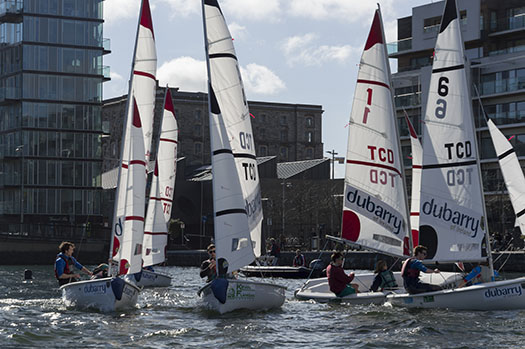
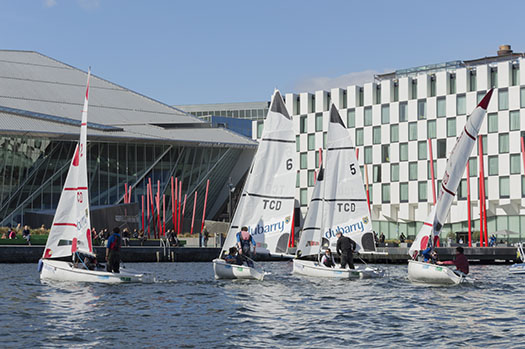
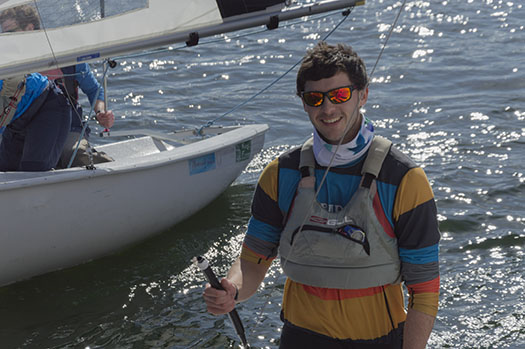
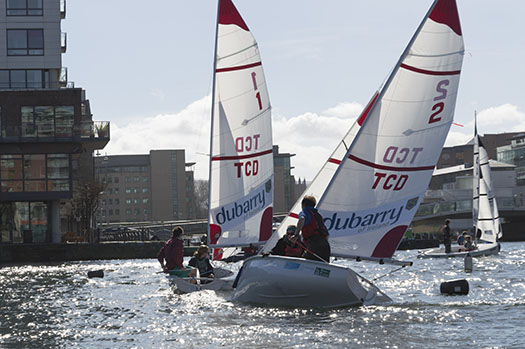
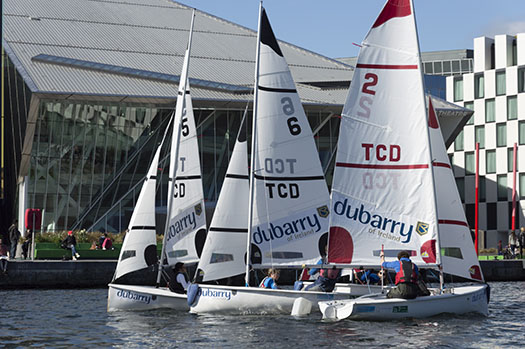
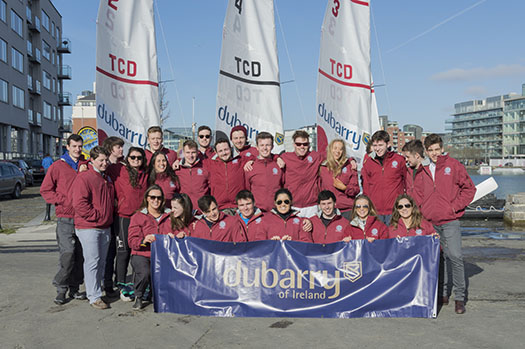
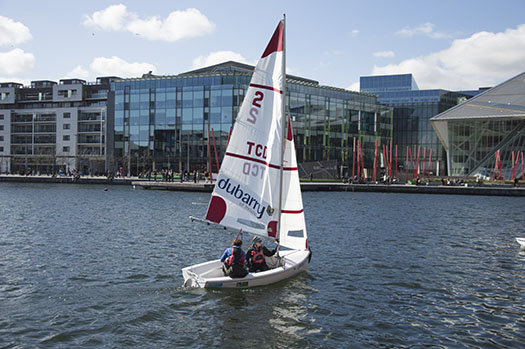
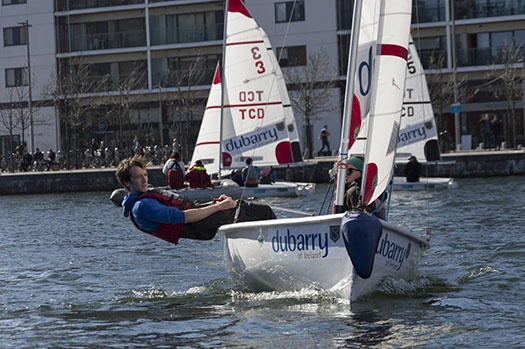
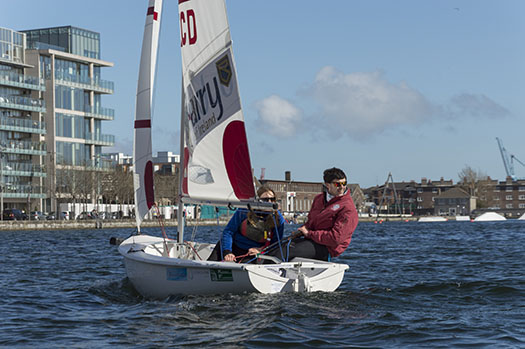
UCD Boat Club Seek Bank Tank Bid Support
#ucdboatclub – UCD Boat Club has launched an online crowdfunding campaign on PledgeSports.org to raise money to refurbish its training Bank Tank in Islandbridge.
The 98-year-old team, a regular at the Henley Royal Regatta, Colours, and the Irish National Championships, has set up this project to give supporters the opportunity to meet the team, row with the team, train with the team, and even BBQ with the team.
The Bank Tank is located at UCD's boathouse in Islandbridge, Dublin. It is a steel tank on the bank of the river that simulates a seat in a rowing boat. It is a tool for learning and developing technique and is used by all from the most basic beginner to the most elite oarsmen.
Shauna Fitzsimons, UCD Boat Club's cox, said: "The two tanks at our boathouse in Islandbridge have withstood the Irish weather for somewhat of an eternity and it is time for a new group of oarsmen and women to learn to row and perfect their technique in a much-needed refurbished bank tank.
"The tank needs shoes, seats and slides, rigs, oars and some general refurbishment and reinforcement of the walls. This project, despite being seemingly simple, is a costly one and your support, big or small, would be greatly appreciated. Help us power UCD and Irish rowing upstream, fast!"
Among the rewards UCD Boat Club is offering for supporters of its PledgeSports.org campaign is a trial of the Bank Tank at a summer BBQ, commemorative wrist bands, and rowing lessons. Visit PledgeSports.org for more.
#colourmatch – This Saturday, Trinity Sailing Club hosts its Colours team racing Event at a new Grand Canal Dock venue in Dublin city. All six UCD and TCD teams will compete against each other in the Dubarry of Ireland sponsored event. A flyer on the event is downloadable below. Read our Colours Match event report and photography HERE.
Traditionally this event takes place in Dun Laoghaire harbour but after the success of last year's match, which took place on the River Liffey in front of the Convention Centre, Trinity is taking the event to another new and unique location – Grand Canal Dock. Racing begins at 10a.m. sharp with a head to head, best of three matches between the corresponding teams, starting with TCD6 vs. UCD6.
In the afternoon the traditional Alumni and Ladies' races will take place before the two First teams compete for the title of winners of Colour's 2015.
All are welcome to come down and watch some competitive racing this Saturday.
Clean Sweep for Trinity over UCD on Liffey
#ROWING: Trinity won all four Colours races on the Liffey today. In the Gannon Cup for senior men, the men in black and white hoops took a small early advantage, stretched it to three-quarters of a length by Capel Street Bridge and won by one-and-a-half lengths. The two novice races were surprisingly one-sided for the Dublin University crews. The best race of the day was the women’s senior contest, for the Corcoran Cup. UCD took an early advantage and led for most of the race. But Trinity were impressively controlled in their rowing and took the lead through the last two bridges. They stretched their advantage to half a length at the finish.
Colours Races 2015, Liffey, Dublin, Saturday, March 14th.
Senior Men (Gannon Cup): Trinity (A Browne, W Doyle, J Magan, M Corcoran, P Moreau, M Kelly, L Hawkes, D Butler; cox: C Flynn) bt UCD 1½ l
Novice (Dan Quinn Shield): Trinity bt UCD, easily
Senior Women (Corcoran Cup): Trinity (G Crowe, H O’Neill, H McCarthy, S Healy, S O’Brien, A Leahy, L McHugh, R Morris; cox: N Williams) bt UCD ½ l
Novice (Sally Moorhead trophy): Trinity bt UCD easily
Trinity Battle Through Headwind to Win Dublin Head
#ROWING: Trinity’s senior eight, fresh from setting a course record at the Erne Head of the River, continued their winning run at the Dublin Head of the River today. In sunny but testing headwind condtions they covered the course from the Marlborough Street steps to Islandbridge in 14 minutes and seven seconds. The Trinity intermediate eight finished second fastest, while UCD were the top men’s novice crew.
Dublin Head of the River, Marlborough Street Steps to Islandbridge, Saturday
(Selected results)
Overall: 1 Trinity men’s senior eight 14 minutes 7 seconds, 2 Trinity intermediate eight 14:23, 3 UCD inter eight 15:11, 4 Commercial inter eight 15:57, 5 Neptune masters eight 17:03, 6 UCD novice eight 17:04.
Men
Eights – Senior: Trinity 14:07. Inter: Trinity 14:23. Novice: UCD 17:04. Junior 18: Commercial A 17:29. Masters: St Michael’s 17:18 (adjusted).
Women
Eights – Senior: Trinity 17:25 (timing only). Novice: Commercial 19:19. Masters: Tribesmen 20:20. Junior 18: Commercial 19:06.
Junior Eight Best at St Michael's Head of the River
#ROWING: The junior A eight from St Michael’s were the fastest crew at the St Michael’s Head of the River at O’Brien’s Bridge today. Carlow’s intermediate four were just three seconds slower. The St Michael’s senior eight, rowing in unfavourable conditions later in the day, could only manages sixth place overall. The UCD B eight were the fastest women’s crew.
St Michael’s Head of the River, O’Brien’s Bridge, Saturday (Selected Results)
Overall: 1 St Michael’s A junior 18 eight 10 minutes 52 seconds, 2 Carlow intermediate four 10:55, 3 St Michael’s inter eight 10:56, 4 Commercial senior quadruple sculls 10:57, 5 Commercial Club Two eight 11:05, 6 St Michael’s senior eight 11:09.
Men
Eight – Senior: St Michael’s 11 minutes 9 seconds. Inter: St Michael’s 10:56. Club Two: Commercial A 11:05. Junior 18: St Michael’s A 10:52. Jun 16: Col Iognáid 11:21. Masters: Fermoy 11:39.
Four – Senior: St Michael’s 11:11. Inter: Carlow 10:55. St Brendan’s Junior 18, coxed: Col Iognáid 13:14. Masters: Galway 13:23.
Pair – Junior 18: Athlunkard 13:04.
Sculling
Quadruple – Senior: Commercial 10:57. Inter: Garda 11:10. Novice: St Brendan’s (coxed) 16:21. Club Two: Clonmel 12:44. Jun 18: Presentation 11:33. Jun 16: Commercial A (coxed) 12:07. Masters: Shandon 11:53.
Double – Senior: Castleconnell/Portadown 11:33. Inter: Presentation 12:05, Killorglin 12:05. Jun 18: Fermoy B 12:31.
Single – Senior: St Michael’s (D O’Connor) 12:19. Inter: Garda 12:26. Novice: Castleconnell (A Mozdzer) 14:22. Jun 18: Waterford (A Goff) 12:38. Jun 16: Commercial (E Meehan) 13:43. Masters: Cahir 13:22.
Women
Eight – Senior: UCD B 11:45. Novice: Commercial C 13:19. Club Two: Galway 12:56. Jun 18: Shannon 11:47. Jun 16: Col Iognáid 14:29. Masters: Shannon 14:58.
Four – Inter: Shannon (coxed) 13:40. Novice: Fermoy B (coxed) 13:51. Jun 18: Carlow A 13:07. Jun 16: Cork 13:06. Masters: Tribesmen 14:58.
Pair – Senior: Shannon A 13:43. Inter: Univ of Limerick 14:49. Jun 18: Shannon 14:37.
Sculling
Quadruple – Club Two: Athlunkard (coxed) 13:02.
Double – Inter: Carlow 14:13. Jun 18: Cork A 14:18.
Single – Inter: St Michael’s (A O’Sullivan) 14:34. Novice: Fermoy (E Kinsella) 17:24. Jun 18: Fermoy (S Cotter) 14:59. Jun 16: Workmans (S Burns) 15:24.


























